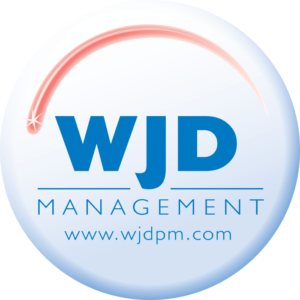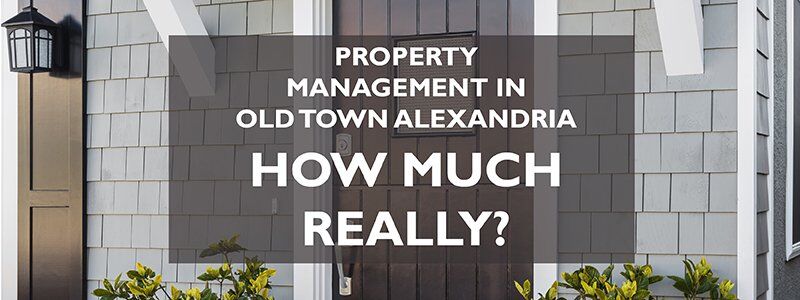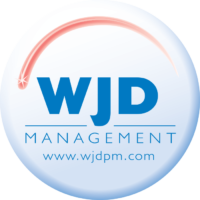Property Management in Old Town Alexandria Virginia
Are you looking for real advice about property management in Old Town Alexandria Virginia? We’ve got the advice you need for property management in Old Town Alexandria, Virginia.
How much does it really cost?
You live in Alexandria, Virginia, and you recently learned you’re being transferred overseas for the next couple of years. You’re excited about the big new transition. There’s one problem, though: To keep your house, you know you’ll have to become a landlord. Which means somehow dealing with rent collection each month, the intrusion of 2 a.m. phone calls into your sound sleep when something breaks, the paperwork at tax time, the hassle of finding good contractors to fix stuff, etc., etc.
So, you’re mulling over hiring an Old Town Alexandria property management company to take over all of your landlord work. Of course, you want to know what that’ll cost you—and (more importantly) whether you’ll be cashflow-positive after paying your mortgage, condo fee, maintenance expenses, etc.
Most Important Advice on Rental Cash Flow
The first piece of advice I give to homeowners about cash flow on rentals is that with or without a property manager, you probably will not make a profit on your rental in this current market. In fact, you will probably lose money during the time your house is being rented. The big question for a homeowner in Alexandria is not, how much can I make from rental income? The bigger question for homeowners throughout Northern Virginia is this one:
Will it be best for me to sell my home or lease it?
And the answer to that question all depends on what you bought your house for and what you could net from it after paying agent commissions and other transactional costs.
It also depends on the sentimental value your home has for you and your family, as well as the likely future expense of buying a comparable house to live in once you return from your transfer.
If you think you probably ought to look into selling, then get a comparative market analysis from a good Alexandria Realtor. But, if you are pretty sure you’ll be better off renting, then keep reading.
What Does a Property Manager Cost?
One important consideration many prospective landlords overlook is that the property manager’s fee—usually a percentage of the rent—is different from other fixed costs such as the mortgage, condo or HOA fee, homeowners’ insurance, real estate tax, etc.
Here’s why: If you hire a good property management firm, the monthly management fee is a strategic cost, and it’s nearly always a mere single digit percentage of the rent collected.
Think of a professional management fee as a payment designed to manage risk, enforce the lease, and control the expenses related to repairs and tenant neglect or misuse of a property. You could certainly attempt to manage the property yourself, but usually a professional can manage your property more efficiently than you could (especially if you live far away from the property). Property management firms leverage long-term relationships with contractors, labor costs that reflect the high volume of services they contract for, and a number of resources (like portable air conditioners during AC repairs so tenants don’t have to go to a hotel) to mitigate landlords’ out-of-pocket costs.
Keep in mind, rental management is a competitive field. Property managers stay in business only if they make it cost-effective for their clients to hire and keep them.
Property Management in Old Town Alexandria: Jan’s Story
So, let’s walk through a typical scenario for a townhouse in Old Town Alexandria.
First, you need to know what the best rental price is for your property. Let’s say a homeowner named Jan owns a 3-bedroom townhouse on Queen Street. She got a custom rental analysis from WJD and found out the most competitive market rent for her house (which has a market value over $900,000, is $3,975/month.
So, the number we begin with in figuring out cash flow is the rental income: $3,975
Jan’s Expenses as a Landlord
The next part is to calculate expenses. Jan would begin by getting her annual real estate tax and insurance figures ready. (She’ll be doing some division in a moment to turn those into monthly expenses, but first we want her to have the actual figures ready—especially if she does not pay them through her mortgage company.)
Mortgage Expenses
Now, Jan will get the monthly mortgage figure. That is, just the principal and interest.
Jan’s principal and interest on her loan—a 30-year conventional mortgage at 4.125 percent—comes out to $2,000/month.
By the way, since Jan happens to have 13 years of equity in her home, she might want to look into refinancing her mortgage and getting that monthly principal and interest cost down further. But for now, let’s assume she’s going to keep her $2,000/month P&I payment.
Real Estate Taxes
The real estate tax payment is the next big fixed expense Jan must factor into the cash flow equation. The annual tax amount for her townhouse in Old Town is $8,400. So, Jan will divide her taxes by 12. That’s $700/month.
Unfortunately, there’s really no way to get around real estate taxes—and you know all too well as a Northern Virginia homeowner that they’re steep. However, keep in mind, you’re also fortunate enough to live in an area famous for its great schools and its attractiveness to professionals with high incomes (or, in the case of government workers) stable incomes.
Yes, those taxes are high—but they’re also part of the price you pay for living in an area where there is always a demand for housing.
Real Estate Taxes: $700/month
Insurance
Homeowner’s insurance comes next. Jan’s policy costs $1,200 a year, so she’ll divide by 12 and add another $100/month in expenses. (That may go up a bit once the house becomes a rental property, so Jan should probably get an estimate from her insurance agent. But for now, we’ll factor in her current insurance costs to get her a fairly reliable cash flow estimate.)
Insurance: $100/month
Homeowners Association Dues
Oh, and she must not forget the HOA dues. That’s $200/month. Which includes a community center with amenities like a swimming pool and small fitness center. The upside? These amenities will make Jan’s townhouse more attractive to young professionals than a similar townhouse with no community resources. The downside? They could also go up at any time.
HOA: $200/month
What are Jan’s fixed monthly expenses?
If she adds up mortgage payment, taxes, insurance, and HOA fees, Jan has a sum of $3,000 in fixed monthly expenses. In other words, the inescapable expenses relating to owning her property (assuming she does not refinance her mortgage) are $3,000.
Now let’s look at what the expenses are if Jan rents out her property under professional management. First things first….
What is Jan’s Property Management Fee?
What property management fee should Jan expect to pay? Some management companies in the area charge homeowners as much as 10 percent of the rent price for management each month. To hire WJD to manage her home while she’s gone, Jan’s cost would be an 8 percent monthly fee. Eight percent of $3,975 comes to $318.
Property Management for this townhome in Old Town Alexandria: $318
Now we’re up to $3,318 in monthly expenses.
Is She Done With Expenses?
No, there are a few more things Jan must factor in as a landlord.
One is that she can expect to have vacancies sometimes, like when she first lists the rental and in between tenants. (Keep in mind, WJD keeps vacancies lower than many of our competitors by building language into the lease agreement that protects landlords to the fullest extent of the law. You can read more about our Surrender of Possession agreement here.)
We recommend landlords factor in a 5 percent vacancy expectation into their profit and loss calculation. For Jan, that monthly figure will be $199.
Monthly Vacancy Cost: $199
Repairs and Maintenance
And then there are the inevitable repairs. While a lot depends on the age of the home and the condition it’s in, we have found in our 30+ years in business that it’s best to set aside 15 percent each month for repairs. For Jan, that’s $596. She may not spend that much, of course—but she needs to plan for the possibility of 15 percent of the rent she collects being used to pay for labor and equipment to keep everything running smoothly in the home.
Monthly Repairs and Maintenance: $596
One final expense Jan must take into account is not a monthly cost—it’s a one-time leasing fee equivalent to one month’s rent. What is this cost? It’s the fee that Realtors and property management firms typically charge to find a tenant. In her case, that’s $3,975. (Just to have an apples to apples comparison, let’s roll that leasing fee into the full 24 months she expects to be renting out the property. Divided by 24, that fee comes to an additional $166/month.
Leasing Fee (averaged across 24 months): $166
Jan’s Total Monthly Costs: WITH Property Management
If WJD managed Jan’s property, the monthly cost figure she should apply for the purposes of comparison is $4,279/month. ($484 of which would be management and leasing fees).
Included in that cost would be advertising and marketing for the property, tenant screening, lease preparation, walk-throughs, rent collection, handling of security deposit, regular checks on the property, preparation of tax filing documents, and all the tasks that go with tenant communication. (For a full list of what a property manager does for the fees charged, check out this article on our blog.)
Jan’s Total Monthly Costs: WITHOUT Property Management
What would Jan’s expenses be without any professional property management services at all?
It’s hard to tell exactly—a lot depends on the quality of the tenants she selects and how well they care for the property. But her expenses without the management fee will be $3,961—almost exactly what she’s getting in rent.
And of course, as her own property manager Jan would immediately begin facing expenses and demands on her time as she advertises the property and goes about doing credit checks (and other screening) on tenant applications.
But there’s a lot more to saving Jan money than getting a good tenant into the property. Let’s examine the services that’ll save her substantial time and money during her tenure as a landlord.
A Closer Look: How Will Property Management Save Jan Money?
Jan will thank us when April 15 rolls around. We haven’t talked yet about income tax filing, but it’s a big area of landlord cost savings.
First off, property management services are a tax-deductible expense.
So, assuming Jan is in a 30 percent tax bracket, her total after-tax property management expense over the two years will actually be about $339 a month more than self-management, not $484 . (That’s not an expense she can deduct, by the way, if she does her own DIY management and tenant placement.)
Add to that the detailed recordkeeping services we perform for every homeowner client on a monthly basis. Would Jan track and record every single expense and then generate a full report at year-end? Maybe, maybe not. But one thing’s for sure—it would take her some time to do it. And she’d have to be more organized than most landlords with full-time jobs.
Let’s assume that Jan actually did pay 15 percent of each month’s rent in repairs and maintenance. We’d make sure that every penny of those expenditures could be deducted from her annual tax return. That’ll be $4,320 in deductions—with an actual tax savings for Jan (again, assuming she’s in the 30 percent tax bracket) of $1,296
Now let’s look at the matter of vacancy. Would Jan be able to screen tenants with the thoroughness and efficiency that an experienced property management firm could? Probably not. One month’s lost rent as a result of a prolonged vacancy? That’s $3,975.
Eyes on the Property—What Does it Save You?
Next, let’s examine the impact of having “eyes on the property” while a landlord is out of the area. We are able to spot lease infractions like unauthorized pets on the premises—and nip those infractions in the bud. What’s the cost of replacing flooring and carpets after a house is subjected to two years of cat urine? For a townhouse, probably a minimum of $7,500—about $130 shy of two years of property management fees.
Through our periodic inspections, we can also assess whether tenants are ignoring the no-smoking policy. Thereby saving thousands of dollars in full-house treatments to remove smoke odors.
Rigorous Checkout Before Security Deposit is Refunded
Finally (and this can be one of the most contentious parts of being a landlord), keep in mind that the final checkout of a tenant is when the security deposit refund is determined. WJD holds tenants to a rigorous final walk-through and check-out process before determining the security deposit refund.
Just take a look at a few the negative Yelp and Google Plus reviews about us – each was posted by a former tenant who either did something they should not have done or failed to do something they should have done and forfeited their security deposit to our clients as a result.
Most of our clients do not have the ability to conduct this kind of check-out in person, and even if they did, they might overlook costly items. What if you ended up having to hold on to an entire security deposit for painting, repairs, house cleaning and yard cleanup? Here again, you pocket $3,975—a full month’s rent—that you might have had to count as a loss without the management assistance.
Jan’s Apples to Apples Comparison: Professional Management vs. Self-Management
By our calculations, Jan would pay WJD Management about $11,600 during the course of her two-year overseas assignment. After taking the tax deductions, the actual cost of our services to Jan would be about $8,120.
Assuming a possible prolonged vacancy, pet- or smoking-related costs, demanding tenants, and the inability to properly assess security deposit refund—we figure Jan would pay about $16,000 to $20,000 over the course of two years. Most, if not all, of those will be tax-deductible, but let’s assume she is like most landlords and only records about half of all her deductible expenses. If she records $10,000 of the numerous invoices and receipts related to the upkeep of the property, her costs would actually be between $13,000 and $17,000.
The upshot?
We feel confident we’ll save Jan money. In fact, we wouldn’t be surprised if we save her at least as much as she pays for our professional property management services while she’s away.
And, if she’s like most of our clients, she’ll find the freedom to focus on her overseas assignment will make her more successful in her work (which, after all, is the whole reason for accepting an exciting overseas job assignment).
Perhaps most importantly, we’ll make sure Jan’s Old Town Alexandria dream house is well cared for. That tenants are professionally screened for credit and employment histories, the lease is enforced, the full market value is preserved, and the house is move-in ready for her when she returns. Pretty impossible to do from overseas—and it’s what WJD has specialized in for more than 30 years.
Performing these calculatons is a major step toward predicting your cashflow–but if you don’t choose the right property management company, you could end up spending thousands on vacancies, court costs, contractors, and attorneys.
If you would like to learn more about WJD Management, please review our comprehensive Management Program guide. If you are ready to rent your home, feel free to take advantage of our exclusive FREE Rental Market Analysis. Finally, don’t forget to connect with us on social media! Follow us on Facebook, Twitter, LinkedIn, Instagram, and Pinterest for tips, ideas and updates.


